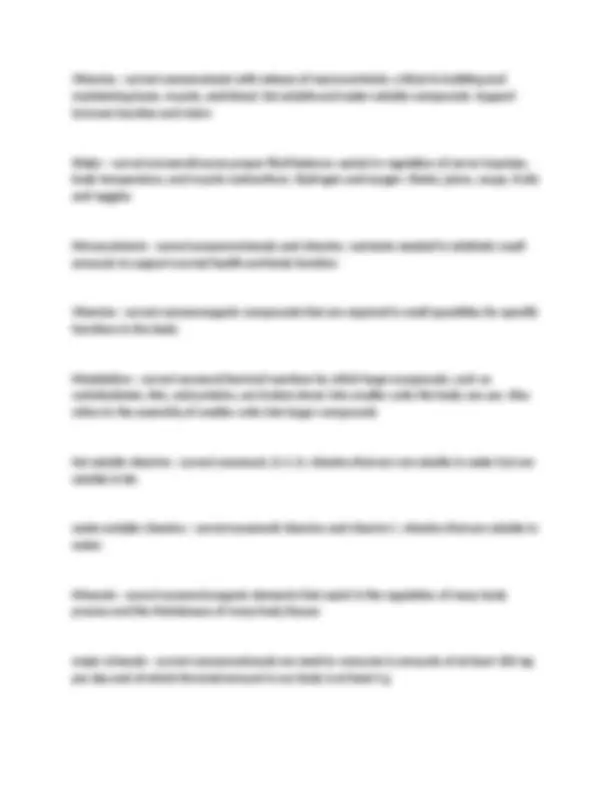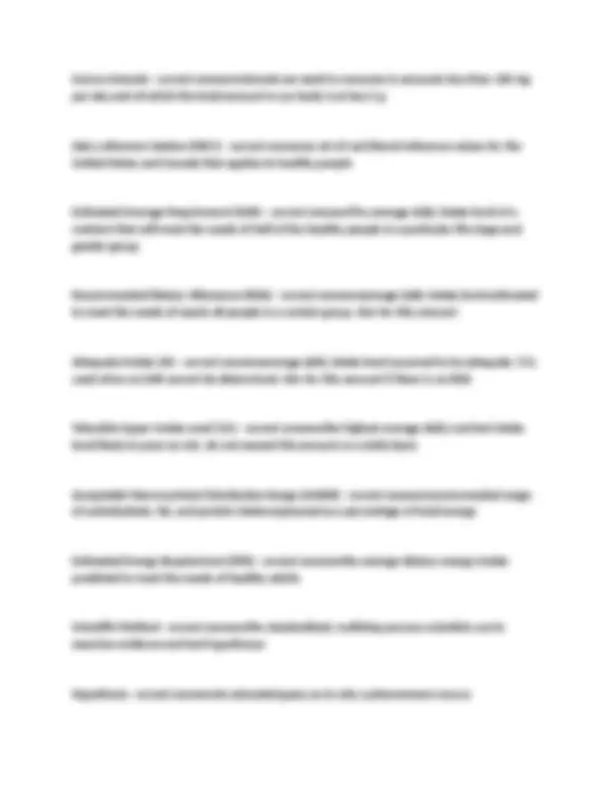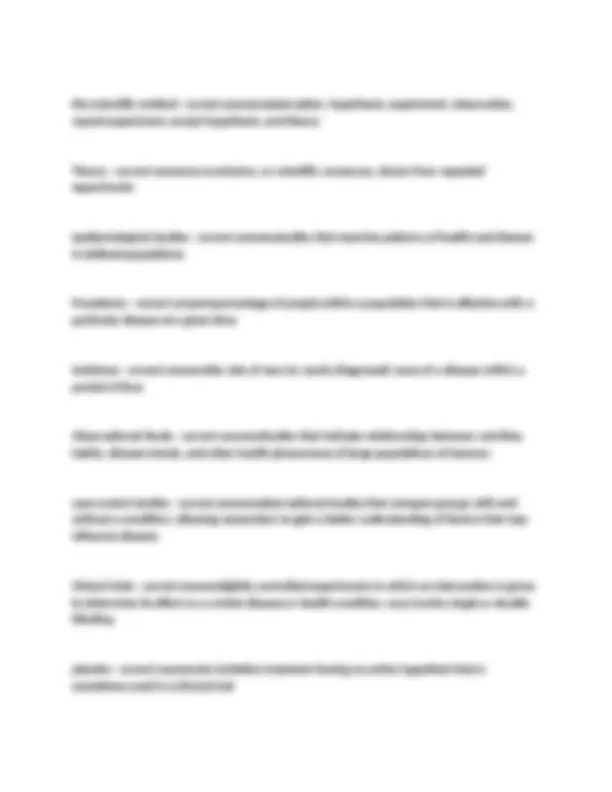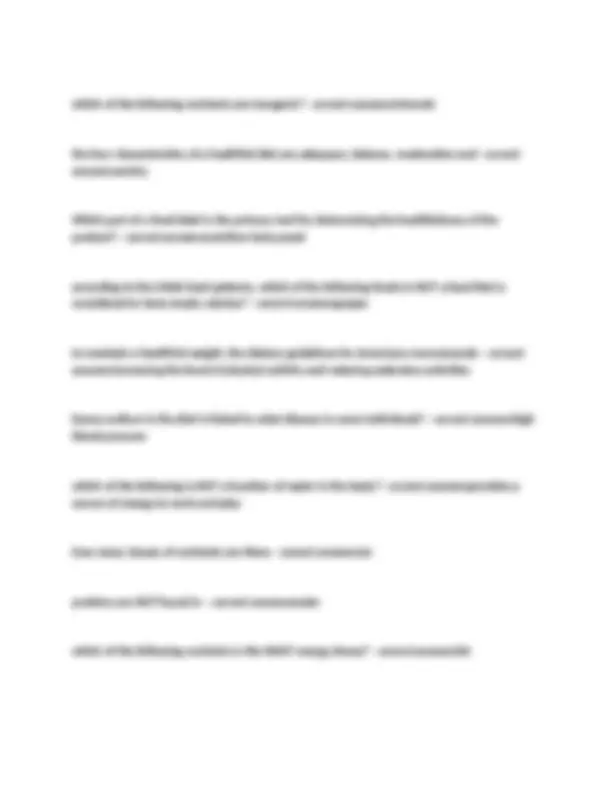






Study with the several resources on Docsity

Earn points by helping other students or get them with a premium plan


Prepare for your exams
Study with the several resources on Docsity

Earn points to download
Earn points by helping other students or get them with a premium plan
Community
Ask the community for help and clear up your study doubts
Discover the best universities in your country according to Docsity users
Free resources
Download our free guides on studying techniques, anxiety management strategies, and thesis advice from Docsity tutors
Nutrition Chapter 1 jersey college Exam Questions with correct answers.
Typology: Exams
1 / 8

This page cannot be seen from the preview
Don't miss anything!





food - correct answersrefers to the plants and animals we consume Nutrition - correct answersthe science that studies food and how nourishes our body and influences our health chronic disease - correct answersdisease develops slowly and can persist for years, often despite treatment. These include obesity, cardiovascular disease, type 2 diabetes Wellness - correct answersa multidimensional, active process by which people make choices that enhance their lives pellagra - correct answersdeficiency disease caused by a lack of niacin scurvy - correct answersa disease caused by lack of vitamin C diseases that are among the top 10 causes of death in the U.S. - correct answersdiabetes, heart disease, and stroke 6 groups of nutrients - correct answerscarbohydrates, proteins, fats, vitamins, minerals, water Nutrients - correct answerschemicals found in foods that are critical to human growth and function
organic - correct answersa substance or nutrient that contains the elements carbon and hydrogen Inorganic - correct answersa substance or nutrient that does not contain carbon and hydrogen Macronutrients - correct answersNutrients that make up the largest part of the nutrition we take in; the three basic food groups: protein, carbohydrates, and fats. carbohydrates, proteins - correct answers4 kcal/g Alcohol - correct answers7 kcal/g fat - correct answers9 kcal/g. AMDR 20 - 35% Carbohydrates - correct answersprimary source of energy for the body, has a carbon, hydrogen, and oxygen. whole grains, veggies, and fruits. AMDR 45 - 65% Protein - correct answerssupports tissue growth, repair, and maintenance. Amino acids made up of carbon, hydrogen, oxygen, and nitrogen. meats, dairy products, seeds, nuts and legumes. AMDR 10 - 35% Minerals - correct answersAssists with fluid regulation and energy production. Maintain health of blood and bones, rid body of harmful by-products of metabolism. Single elements such as sodium, potassium, calcium, or iron. Fruits, veggies, dairy products, and meats fats and oils - correct answersimportant source of energy at rest and during low-intensity exercise. Carbon, hydrogen, and oxygen. Veggies, oils, butter, and dairy products
trance minerals - correct answersminerals we need to consume in amounts less than 100 mg per day and of which the total amount in our body is at less 5 g dairy reference intakes (DRI's) - correct answersa set of nutritional reference values for the United States and Canada that applies to healthy people Estimated Average Requirement (EAR) - correct answersThe average daily intake level of a nutrient that will meet the needs of half of the healthy people in a particular life stage and gender group Recommended Dietary Allowance (RDA) - correct answersaverage daily intake level estimated to meet the needs of nearly all people in a certain group. Aim for this amount Adequate Intake (AI) - correct answersaverage daily intake level assumed to be adequate. It is used when an EAR cannot be determined. Aim for this amount if there is no RDA Tolerable Upper Intake Level (UL) - correct answersthe highest average daily nutrient intake level likely to pose no risk. do not exceed this amount on a daily basis Acceptable Macronutrient Distribution Range (AMDR) - correct answersrecommended range of carbohydrate, fat, and protein intake expressed as a percentage of total energy Estimated Energy Requirement (EER) - correct answersthe average dietary energy intake predicted to meet the needs of healthy adults Scientific Method - correct answersthe standardized, multistep process scientists use to examine evidence and test hypotheses Hypothesis - correct answersAn educated guess as to why a phenomenon occurs
the scientific method - correct answersobservation, hypothesis, experiment, observation, repeat experiment, accept hypothesis, and theory Theory - correct answersa conclusion, or scientific consensus, drawn from repeated experiments epidemiological studies - correct answersstudies that examine patterns of health and disease in defined populations Prevalence - correct answerspercentage of people within a population that is affective with a particular disease at a given time incidence - correct answersthe rate of new (or newly diagnosed) cases of a disease within a period of time Observational Study - correct answersStudies that indicate relationships between nutrition habits, disease trends, and other health phenomena of large populations of humans case control studies - correct answersobservational studies that compare groups with and without a condition, allowing researchers to gain a better understanding of factors that may influence disease clinical trials - correct answerstightly controlled experiments in which an intervention is given to determine its effect on a certain disease or health condition. may involve single or double blinding placebo - correct answersAn imitation treatment having no active ingredient that is sometimes used in a clinical trial
What does early nutrition research focus on? - correct answersidentifying and preventing disease caused by dietary deficiencies what are vitamins A and C, thiamin, calcium and magnesium? - correct answersmicronutrients nutrigenomics - correct answersA scientific discipline studying the interactions between genes, the environment, and nutrition. human microbiome - correct answersthe complete population of microorganisms, including their genes, that inhabit the human body functional foods - correct answersFoods that may have biologically active ingredients that provide health benefits beyond basic nutrition. probiotics - correct answersFoods, beverages, or supplements containing living microorganisms that beneficially affect consumers by improving the intestinal microbial balance. Prebiotics - correct answersNondigestible food compounds that support the growth and/or activity of one or a limited number of bacteria in the large intestine. processed foods - correct answersfoods that have been manipulated in some way to transform raw ingredients into products for consumption phytochemicals - correct answersnaturally occurring plant compounds believed to have health-promoting effects in humans whole foods - correct answersfoods that have been modified as little as possible, remaining in or near their natural state
which of the following nutrients are inorganic? - correct answersminerals the four characteristics of a healthful diet are adequacy, balance, moderation and - correct answersvariety Which part of a food label is the primary tool for determining the healthfulness of the product? - correct answersnutrition facts panel according to the USDA food patterns, which of the following foods in NOT a food that is considered to have empty calories? - correct answersgrapes to maintain a healthful weight, the Dietary guidelines for Americans recommends: - correct answersincreasing the level of physical activity and reducing sedentary activities Excess sodium in the diet is linked to what disease in some individuals? - correct answershigh blood pressure which of the following is NOT a function of water in the body? - correct answersprovides a source of energy to work and play how many classes of nutrients are there - correct answerssix proteins are NOT found in: - correct answerswater which of the following nutrients is the MOST energy dense? - correct answersfat